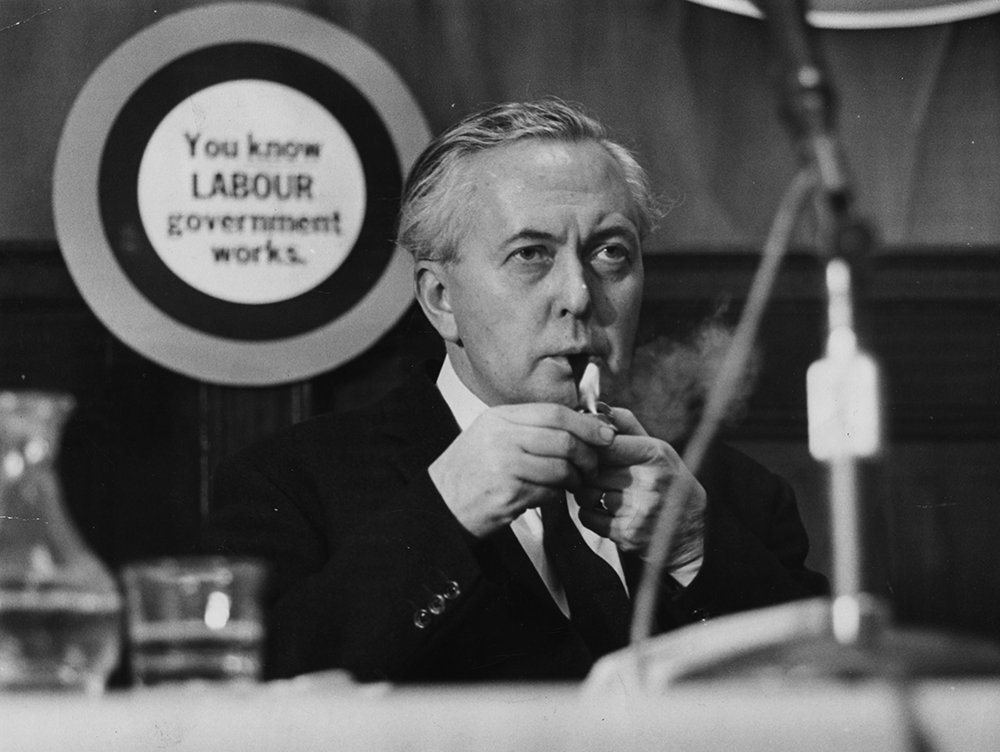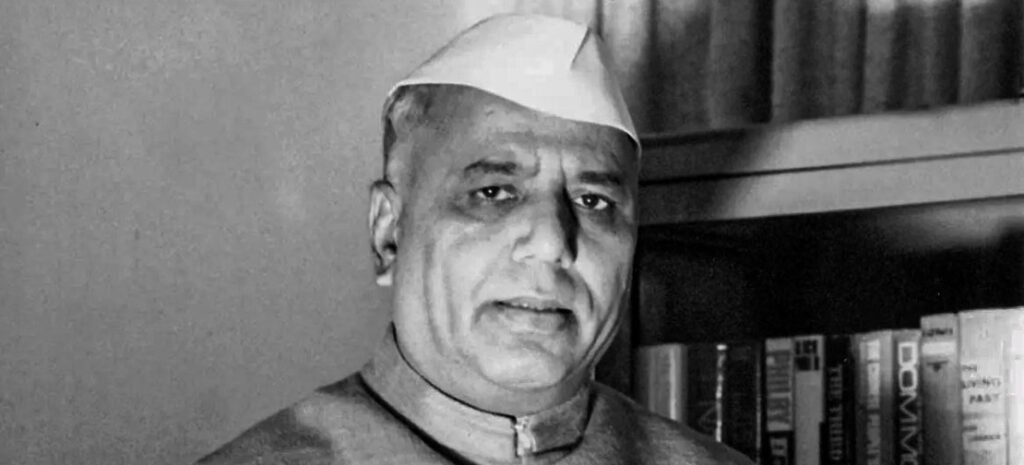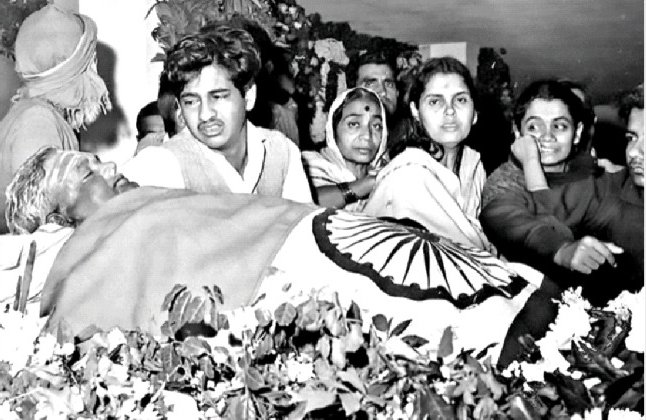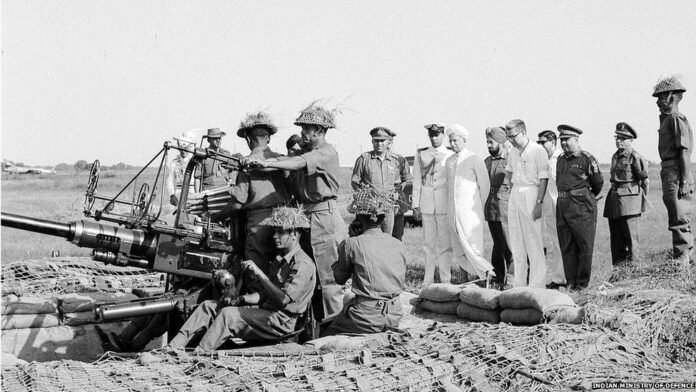In May 1964, India’s Defence Minister Yashwantrao Chavan visited the Pentagon, the HQ of the US defence department. Chavan, who was trying to rapidly modernise the Indian military, requested the Americans to sell India the F-104 Starfighter – the most advanced jet fighter of that era.
The United States supplied modern fighters such as the F-104 fighters and F-86 Sabre in large numbers – virtually free of cost – to Pakistan, but India’s request was rebuffed in an extremely crude manner.
In his brilliant little book, ‘1965 War: The Inside Story’, former Maharashtra chief secretary RD Pradhan narrates what US Defence Secretary Robert McNamara told Chavan: “Mr Minister, your air force is like a museum. I wonder whether you are aware of the variety of aircraft in your air force. You are still operating with Hunters, Spitfires, Vampires, Liberators, Harvards – exotic names of World War II vintage. All these aircraft are only worthy of finding a place in a museum.”
McNamara suggested that until India disbanded that fleet, it was no use acquiring any sophisticated aircraft. What the American secretary said was offensive – and true. Prime Minister Jawaharlal Nehru and his Defence Minister VK Krishna Menon had severely handicapped India’s armed forces by refusing to acquire modern weapons, insisting that the police were sufficient to secure India’s borders.
Despite this, however, what Indian troops did with the antiquated planes and vintage tanks was commendable. Says Pradhan: “With that background, it was an exhilarating moment when some of those junk planes, such as the Mysteres, Vampires and Hunters performed brilliantly against Pakistan’s sophisticated F-86s. In fact, the indigenously built Gnat, a small beaver-like fighter, brought down several F-86s.”
The 1965 War remains memorable for two reasons. One was a monumental miscalculation by Pakistan. President Ayub Khan, egged on by his scheming and feckless Foreign Minister Zulfikar Ali Bhutto, sent a top-secret order to his army chief General Mohammed Musa: “As a general rule, Hindu morale would not stand for more than a couple of hard blows delivered at the right time and the right place. Such opportunities should therefore be sought and exploited.”
Secondly, India’s leadership – as it had done consistently over the past two millennia – surrendered on the negotiating table what the soldiers had won on the battlefield. Pradhan writes: “In a way, India’s leadership, out of its sense of restraint, fair play and endeavour to seek enduring peace and goodwill with the neighbour, seems to have missed opportunities to solve the problem.”
Russia supported the Indian position that the Security Council should only deal with the war and not drag in the Kashmir issue. During the thick of the war, India received a reassuring message from Russian Premier Alexei Kosygin indicating support in the event of a Chinese attack
At the end of a bruising 17-day war, India held 1,920 square kilometres of Pakistani territory while Pakistan only held 550 square kilometres of Indian land. The strategic Haji Pir pass – which was, and continues to be, the primary infiltration point for terrorists from Pakistan – was also captured by Indian soldiers after an epic battle. And yet India surrendered everything at the Tashkent Declaration in January 1966.
British – Acting in Bad Faith
The US, which was embroiled in a bloody war of its own in Vietnam, acted mostly through the United Nations. However, the defining Western aim was to see their satellite, Pakistan, get through the war without getting battered. This view is amply summed by Chavan, who wrote about British Prime Minister Harold Wilson’s ceasefire proposal at a time when India had the upper hand: “I insisted on military advantages being maintained. The UK proposals look like a trap.”

As three divisions of the Indian Army were slicing across Pakistani defences and thundering across the Ichhogil canal to Lahore, Wilson sent a message to Prime Minister Lal Bahadur Shastri and Ayub Khan: “Both governments bear responsibility for the steady escalation which has subsequently occurred, and today’s attack in the Lahore area presents us with a completely new situation.”
Wilson’s message implied that India was as much to blame for the war on the subcontinent as Pakistan. “Shastri more or less brushed aside that message,” says Pradhan. “Bias on the part of Britain would rule out the UK from playing any effective role in events after the ceasefire.”
Russian Role
Russia, which was following the events with deep interest, maintained its traditional stand that Kashmir was part of India. Pradhan writes that Moscow accepted the disturbances in Kashmir had been created by infiltrators from Pakistan.
Russia also backed India at the United Nations. K Vijaykrishnan writes in ‘The Soviet Union and the India-Pakistan War, 1965’, “Support was available for India on some important technical points and objections India had raised,” he says. Russia supported the Indian position that the Security Council should only deal with “questions directly connected with the settlement of the armed conflict” and not drag in the Kashmir issue.
Fending off China was a trickier affair. Russia did not want an open confrontation with Beijing, but Moscow decided it would not remain a passive spectator if India had to battle on two fronts. According to Vijaykrishnan, during the thick of the conflict, India received a reassuring message from Russian Premier Alexei Kosygin indicating support in the event of a Chinese attack.
Sisir Gupta writes in ‘India and the International System’ that India was aware that Russia would never like to see India humbled or weakened. “A strong and friendly India occupying a pre-eminent position in South Asia was very much a Soviet foreign policy interest. Notwithstanding the fluctuations in the Soviet attitude and the zig-zag nature of the course it pursued, there was throughout a broad assumption underlying Soviet policies towards South Asia, that India was the key factor in the region and that any policy which created distrust and dissension between the two countries was to be avoided.”
At the end of a bruising 17-day war, India controlled 1,920 sq km of Pakistani territory while Pakistan held only 550 sq km of Indian land. The strategic Haji Pir pass was also captured by Indian troops after an epic battle. And yet India surrendered everything at the Tashkent Declaration in January 1966
China got the message and backed off despite Pakistani appeals for help. Chinese strongman Mao Tse-Tung was reported to have told Ayub Khan that “if there is a nuclear war, it is Peking and not Rawalpindi that will be the target”, writes G.W. Chaudhury in ‘India, Pakistan, Bangladesh and the Major Powers: Politics of a Divided Subcontinent’.
Road to Tashkent
With the US disinterested in the conflict and the UK showing its true anti-India and pro-Pakistan colours, it was left to Russia to play broker. It was after some initial hesitation that both India and Pakistan accepted the Russian offer. Ayub Khan later said that Pakistan went to Tashkent as it did not want to risk a veto by Moscow.
There was another reason for Pakistan’s eagerness for talks. According to Pradhan, “The continued presence of Indian troops on the east side of the Ichhogil canal, facing Lahore city, was hurting Pakistan’s pride.” The heat was clearly on Islamabad.
Before leaving for Tashkent, Shastri – who was hero-worshipped by Indian soldiers – had promised his victorious troops that he would not return the land captured from the enemy after so many sacrifices. But after six days of talks, Shastri proved once again that Indians are bad negotiators. He gave away everything.
Was Shastri feeling the pressure from the international community? Most likely not, but perhaps he felt, like his successor Indira Gandhi did after the 1971 war, that showing leniency towards Pakistan would buy its goodwill.
Shastri was a man of steel during war but became soft in peace, an old Indian malaise. The late Kuldip Nayyar writes that in 1962, when China attacked India, the Shah of Iran sent Nehru a copy of a letter he had written to Ayub Khan, suggesting that he send his soldiers to fight alongside Indian forces against the “red menace”.
“At the end of hostilities, Shastri recalled the Shah’s letter and said that had the Pakistani soldiers fought alongside us and ‘shed their blood with Indian soldiers’, it would have been difficult to say ‘No’ to Pakistan even if it had asked for Kashmir (Agar wo Kashmir bhi mangte to na karna mushkil hota).

Nayyar adds: “Probably he was right because emotions played a substantial part in our decisions.”
That is indeed correct. C.P. Srivastava, who was private secretary to the Prime Minister, writes in his memoirs ‘Lal Bahadur Shastri’ that Shastri believed “it would be easier to make peace with Pakistan, the people of which were of the same stock as Indians, than to make up with China”.
Clearly, Shastri, like many Indians, failed to see the incompatibility of the Judaic religions with India’s dharmic faiths. Like Nehru before him and a multitude of leaders after, Shastri believed that Pakistan wanted peace. But Pakistan does not want peace; it only wants – rather vainly hopes – to re-establish Muslim rule over the Indian subcontinent.
Chanakya wrote 2,300 years ago that the antidote to poison is poison, not nectar. Yet Indian leaders waste time and effort trying to appease Pakistan. It is the equivalent of trying to stop a scorpion from stinging.

Mystery of Shastri’s Death
If you were Shastri, you would dread having to face the Indian soldier back home. Many had paid the ultimate price while capturing the strategic Haji Pir pass, which, if India had kept, would have forever nullified Pakistan’s advantage in Kashmir.
On the night of January 10, 1966, the Prime Minister succumbed to a fatal heart attack. This was his fourth cardiac episode, likely brought on by the heavy burden of confronting an angry public and the painful prospect of meeting the eyes of his soldiers — his jawans — whose trust he had betrayed.
There have been all sorts of conspiracy theories, but the truth is that none of the major countries benefited from his death. Russia had scored a spectacular diplomatic coup by brokering a ceasefire. America fully supported the Tashkent Agreement, as its ally, Pakistan, remained in one piece, and Islamabad was happy to get its territories back.
That the Indian Prime Minister probably died of a heart attack comes from a most unlikely source. Shortly after Mikhail Gorbachev’s liberalisation policies of glasnost and perestroika in the late 1980s, Soviet Land magazine in India published an account by an ex-KGB officer.
Before leaving for Tashkent, Prime Minister Shastri promised his victorious troops that he would not return the land captured from the enemy after so many sacrifices. After six days of talks, however, Shastri proved again that Indians are ‘bad negotiators’ by giving away everything
According to the former intelligence agent, the KGB was spying on both the Indian and Pakistani delegations in order to find out how much each country was willing to yield during the negotiations. When Shastri started getting a seizure, the KGB was listening but decided not to alert his aides because that would give away their game and lead to a diplomatic showdown with India.
Logistically Challenged General
Having dissected what transpired at the negotiating table, we need to discuss the prelude to Tashkent.
Although Pakistan was on the verge of being trounced when India generously agreed to a ceasefire after repeated pleas from the major powers. Why did India stop fighting when it had Pakistan reeling? Why did Chavan and Shastri, who ignored Western pressure and gave a free hand to the Indian military, cave in at Tashkent?
The problem was Army Chief Jayanto Nath Chaudhuri. The Kolkata-born general came from an affluent background and had become army chief purely on the back of family connections and pure luck. He was elevated following the resignation of Army Chief Pran Nath Thapar, who was related to Nehru by marriage, and had neglected the country’s defences, leaving the army completely unprepared when the Chinese invaded in 1962.
Chaudhuri’s mentors were the Sandhurst-educated British generals, who had utterly failed before the Germans and Japanese during World War II, and not surprisingly, he lacked war-fighting qualities. “He was so good on paper that Chavan often wondered how good he would be in warfare,” says Pradhan.
Chavan writes in his war diary that Chaudhuri would frequently lapse into depression. Each time the Indian army suffered a setback, the general would walk into the Defence Minister’s room, and Chavan had to give him a pep talk.
Pradhan writes, “On September 20, when the Prime Minister asked Chaudhuri whether India could expect to gain if the war continued for a few days more, he informed the PM that the army was coming to the end of its ammunition holdings and could not sustain fighting for much longer. Chaudhuri advised acceptance of the ceasefire proposal. It was later discovered in overall terms, only 14-20 per cent of the Indian Army’s ammunition stock had been used up. At the moment of our greatest advantage, the army chief’s non-comprehension of the intricacies of the long-range logistics deprived India of a decisive victory.”
In contrast, Pakistan had expended 80 per cent of its ammo and was on the ropes. A few more days, and the Pakistani military would have collapsed.
Chaudhuri was also criticised for his lack of daring. When the Pakistani cities of Sialkot and Lahore could have been easily taken after the dash and bravery shown by Indian troops, Chaudhuri told Shastri, “We must move with the caution and wisdom of an elephant. We will take them in God’s good time.”
For India, 1965 was the year of resurgence in national pride, which had hit rock bottom after the 1962 debacle with China. India launched an armament programme and acquired advanced MiG-21 and Sukhoi Su-7 jets, ground defence radars, air-to-air missiles, anti-ship missiles and warships from Russia
In fact, when the Pakistan Army attacked in the Khemkaran sector, Chaudhuri ordered the Army Commander Harbaksh Singh to withdraw to a safer position. The commander refused, and what followed was the Battle of Assal Uttar – the greatest tank battle since Kursk in 1943. The Indian counterattack on the night of September 10 was so ferocious that by the morning, they had knocked out 70 Pakistani tanks. What the Battle of Assal Uttar will be memorable for is the 25 enemy tanks found abandoned with their engines running and wireless sets on. It was the perfect metaphor for the plight of the Pakistan Army.
Pakistan Army’s Humiliation
According to veteran Pakistani journalist and commentator Najam Sethi, 1965 was a clear defeat for Pakistan. He recalls that when the Indian Army reached the outskirts of Lahore, the BBC announced that India’s frontline troops (of 3 Jat) had entered the Jinnah Gardens and were raising toasts at the gymkhana.
In reality, the rampaging Indian Army had reached the outskirts of Lahore, but due to a lack of intelligence about enemy troops, they did not capture the city. Sethi says the Indians thought it unbelievable that Pakistan’s second-largest city would be left undefended and that it was perhaps a trap. Indian tanks pulled back just long enough for the Pakistan Army to rush in and defend Lahore.
Sethi says that when writer and journalist Tariq Ali asked Bhutto who started the war. It was Bhutto as Foreign Minister who was primarily responsible for Ayub Khan’s decision to grab Kashmir. He admitted it was Pakistan that had initiated the conflict. Bhutto reckoned it was a win-win situation as far as he was concerned. If Pakistan had won, Bhutto – as one of the architects of Operation Gibraltar – would be hailed as a hero. And if Pakistan lost, which was what happened, Ayub Khan would resign, paving the way for Bhutto to become the head of state. (The Pakistan Army never forgave Bhutto for his arrogance and 14 years later executed him after a sham trial.)
For Pakistan, the war was an unqualified disaster because the cost of replacing its huge war losses – including more than 250 American tanks – placed a huge burden on its economy. It made the civilian leadership extremely unpopular, leading to the army seizing power, which sent Pakistan plunging towards anarchy.
1965 was the Prelude to Victory in 1971
From India’s point of view, 1965 was the year of resurgence in national pride, which had hit rock bottom after the 1962 debacle with China. India embarked on a massive rearmament programme, acquiring advanced MiG-21 and Sukhoi Su-7 jets, ground defence radars, air-to-air missiles, anti-ship missiles and warships, among others, from Russia. The shortcomings of the IAF and Indian Army were overcome by frequent war games and exercises, resulting in an excellent war-fighting machine in just six years. When war came again in 1971, India was ready to complete the unfinished business of 1965.
–The writer is a globally cited defence analyst based in New Zealand. The views expressed are of the writer and do not necessarily reflect the views of Raksha Anirveda






